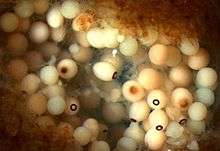Amphimedon queenslandica
| Amphimedon queenslandica | |
|---|---|
 | |
| Scientific classification | |
| Kingdom: | Animalia |
| Phylum: | Porifera |
| Class: | Demospongiae |
| Order: | Haplosclerida |
| Suborder: | Haplosclerina |
| Family: | Niphatidae |
| Genus: | Amphimedon Duchassaing & Michelotti, 1864 |
| Species: | A. queenslandica |
| Binomial name | |
| Amphimedon queenslandica Hooper & Van Soest, 2006[1] | |

Amphimedon queenslandica (formerly known as Reniera sp.[2]) is a sponge native to the Great Barrier Reef. Its genome has been sequenced.[3] It has been the subject of various studies on the evolution of metazoan development.[2][4]
A. queenslandica was first discovered in 1998 on Heron Island Reef by Sally Leys during a survey of sponge species,[5] and was formally described by John Hooper and Rob van Soest in 2006.[1] Like most sponges, it has a biphasic life cycle, passing through a planktonic phase whilst a larva, but later becoming a benthic dweller.[5] It is hermaphroditic, and reproduces via spermcast spawning,[3] meaning it releases sperm into water but retains eggs, which are fertilised internally.[6] The embryos develop in brood chambers until they reach a certain size, then disperse as parenchymella larvae.[5] During this larval stage, they have a strong preference for darkness.[5] The sponge is difficult or impossible to maintain in captivity.[5]
Genetics
The genome of Amphimedon queenslandica was sequenced in 2009 to provide insights into the evolution of animal complexity and remains the only sponge to be sequenced.[3]
References
- 1 2 Hooper, John N.A.; Rob W.M. Van Soeast (2006-09-14). "A new species of Amphimedon (Porifera, Demospongiae, Haplosclerida, Niphatidae) from the Capricorn-Bunker Group of Islands, Great Barrier Reef, Australia: target species for the 'sponge genome project'" (PDF). Zootaxa. Magnolia Press. 1314: 31–29. Retrieved 2010-04-07.
- 1 2 3 Adamska, M.; Degnan, S.; Green, K.; Adamski, M.; Craigie, A.; Larroux, C.; Degnan, B.; Fraser, J. (2007). Fraser, James, ed. "Wnt and TGF-beta expression in the sponge Amphimedon queenslandica and the origin of metazoan embryonic patterning". PLoS ONE. 2 (10): e1031. Bibcode:2007PLoSO...2.1031A. doi:10.1371/journal.pone.0001031. PMC 2000352
 . PMID 17925879.
. PMID 17925879. - 1 2 3 Srivastava, M.; Simakov, O.; Chapman, J.; Fahey, B.; Gauthier, M. E. A.; Mitros, T.; Richards, G. S.; Conaco, C.; Dacre, M.; Hellsten, U.; Larroux, C.; Putnam, N. H.; Stanke, M.; Adamska, M.; Darling, A.; Degnan, S. M.; Oakley, T. H.; Plachetzki, D. C.; Zhai, Y.; Adamski, M.; Calcino, A.; Cummins, S. F.; Goodstein, D. M.; Harris, C.; Jackson, D. J.; Leys, S. P.; Shu, S.; Woodcroft, B. J.; Vervoort, M.; Kosik, K. S. (2010). "The Amphimedon queenslandica genome and the evolution of animal complexity". Nature. 466 (7307): 720–726. Bibcode:2010Natur.466..720S. doi:10.1038/nature09201. PMC 3130542
 . PMID 20686567.
. PMID 20686567. - ↑ Tompkins-Macdonald, G. .; Gallin, W. .; Sakarya, O. .; Degnan, B. .; Leys, S. .; Boland, L. . (2009). "Expression of a poriferan potassium channel: insights into the evolution of ion channels in metazoans". The Journal of Experimental Biology. 212 (Pt 6): 761–767. doi:10.1242/jeb.026971. PMID 19251990.
- 1 2 3 4 5 Degnan, B. M.; Adamska, M.; Craigie, A.; Degnan, S. M.; Fahey, B.; Gauthier, M.; Hooper, J. N. A.; Larroux, C.; Leys, S. P.; Lovas, E.; Richards, G. S. (2008). "The Demosponge Amphimedon queenslandica: Reconstructing the Ancestral Metazoan Genome and Deciphering the Origin of Animal Multicellularity". Cold Spring Harbor Protocols. 2008 (13): pdb.emo108. doi:10.1101/pdb.emo108.
- ↑ Bishop, J. D. D.; Pemberton, A. J. (2006). "The third way: spermcast mating in sessile marine invertebrates". Integrative and Comparative Biology. 46: 398–406. doi:10.1093/icb/icj037.
